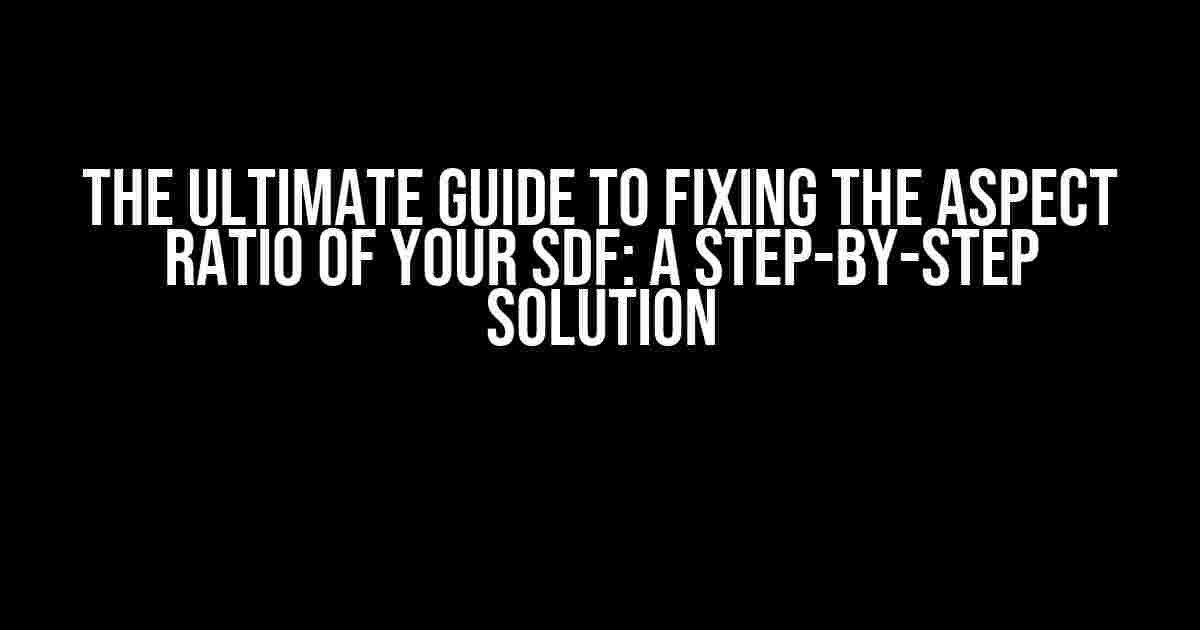Are you tired of dealing with a skewed aspect ratio on your SDF (Signed Distance Field) models? Do you find yourself frustrated with the distorted proportions and wonky shapes? Fear not, dear reader, for we’ve got you covered! In this comprehensive guide, we’ll walk you through the process of fixing the aspect ratio of your SDF, ensuring your models look their absolute best.
Understanding Aspect Ratios and SDFs
Before we dive into the fixing process, it’s essential to understand the basics of aspect ratios and SDFs. A Signed Distance Field is a 3D representation of an object, where the distance from a point to the surface of the object is stored as a signed value. This technique allows for efficient rendering and collision detection. However, when the aspect ratio is off, the entire model can become distorted.
What is an Aspect Ratio?
An aspect ratio refers to the proportional relationship between an object’s width and height. In the context of SDFs, the aspect ratio directly affects how the model is rendered. A 1:1 aspect ratio means the model is rendered in a perfect square, while a 4:3 aspect ratio would render the model slightly more elongated.
In an ideal world, your SDF model would have a perfect 1:1 aspect ratio, ensuring a visually appealing and accurate representation. However, this isn’t always the case, and that’s where we come in!
Identifying the Problem: Signs of a Skewed Aspect Ratio
Before we fix the issue, let’s identify the telltale signs of a skewed aspect ratio:
Stretched or squished shapes: If your model appears stretched or squished in one direction, it’s likely due to an incorrect aspect ratio.Distorted proportions: If the model’s proportions seem off, with certain features appearing too large or too small, it may be an aspect ratio issue.Inconsistent rendering: If your model renders differently across various platforms or software, it could be related to an aspect ratio problem.
Fixin’ Time: Step-by-Step Instructions
Now that we’ve identified the problem, let’s get to the fixing part! Follow these steps to restore your SDF model’s aspect ratio to its former glory:
Step 1: Inspect Your Model’s Metadata
Open your SDF file in a text editor or a 3D modeling software and inspect the metadata. Look for the aspect_ratio or scale property. This will give you an idea of the current aspect ratio and scale of your model.
metadata {
format: "SDF"
version: "1.0"
aspect_ratio: 1.33
scale: 1.0
}
Step 2: Calculate the Correct Aspect Ratio
Determine the correct aspect ratio for your model by measuring its dimensions. Take note of the width and height of your model in its default, undistorted state. You can use a 3D modeling software or a ruler to measure the dimensions.
For example, let’s say your model’s width is 100 units and its height is 80 units. To calculate the aspect ratio, divide the width by the height:
aspect ratio = width / height = 100 / 80 = 1.25
Step 3: Update the Aspect Ratio in the Metadata
Open your SDF file again and update the aspect_ratio property to the calculated value:
metadata {
format: "SDF"
version: "1.0"
aspect_ratio: 1.25
scale: 1.0
}
Step 4: Update the Scale Factor (Optional)
If your model requires a scale factor adjustment, update the scale property accordingly. This step is optional, but necessary if your model needs to be resized:
metadata {
format: "SDF"
version: "1.0"
aspect_ratio: 1.25
scale: 0.5
}
Step 5: Re-save and Re-render
Save your updated SDF file and re-render your model. You should now see a corrected aspect ratio, with your model rendering in its correct proportions.
Common Pitfalls and Troubleshooting
During the fixing process, you might encounter some common issues:
Pitfall 1: Incorrect Aspect Ratio Calculation
If your calculations are incorrect, you may end up with an even more distorted model. Double-check your measurements and calculations to ensure accuracy.
Pitfall 2: Inconsistent Metadata
If your metadata is inconsistent across different files or platforms, it can lead to rendering issues. Ensure that your metadata is consistent and up-to-date.
Pitfall 3: SDF File Corruption
Corrupted SDF files can cause a range of issues, including distorted models. If you suspect file corruption, try re-exporting your model or using a different software to edit the SDF file.
Conclusion
Fixing the aspect ratio of your SDF model is a straightforward process that requires attention to detail and a basic understanding of metadata. By following these steps, you’ll be able to restore your model to its original glory, ensuring a visually appealing and accurate representation. Remember to stay vigilant and address any common pitfalls that may arise during the fixing process.
| Aspect Ratio Issues | Solutions |
|---|---|
| Stretched or squished shapes | Update aspect ratio in metadata |
| Distorted proportions | Calculate correct aspect ratio and update metadata |
| Inconsistent rendering | Check metadata consistency and update software |
With these tools and knowledge, you’ll be well on your way to creating stunning, accurately rendered SDF models that will leave everyone in awe. Happy modeling!
Frequently Asked Question
Got an SDF (Signed Distance Field) file with an aspect ratio that’s driving you nuts? Don’t worry, we’ve got you covered! Check out these FAQs to learn how to fix it.
Why is my SDF file displaying an incorrect aspect ratio?
This could be due to the way the SDF file was generated or exported. Sometimes, the software or tool used to create the SDF file might not preserve the original aspect ratio. Fear not, friend! We’ve got some fixes for you.
How can I fix the aspect ratio of my SDF file using image editing software?
Open your SDF file in an image editing software like Adobe Photoshop or GIMP. Check the image size and adjust it to the correct aspect ratio. You can do this by selecting ‘Image’ > ‘Image Size’ and entering the correct dimensions. Make sure to uncheck the ‘Constrain Proportions’ box to maintain the aspect ratio.
Can I fix the aspect ratio of my SDF file using a 3D modeling software?
Yes, you can! Import your SDF file into a 3D modeling software like Blender. Select the object and check its dimensions in the Properties panel. Adjust the X, Y, and Z axes to match the correct aspect ratio. You can also use the ‘Scale’ tool to proportionally resize the object.
What if I’m working with a programmatically generated SDF file?
If you’re generating the SDF file programmatically, you’ll need to adjust the code that generates the file. Check the functions or methods that create the SDF file and ensure they’re using the correct aspect ratio. You might need to update the code to use the correct dimensions or scaling factors.
Are there any online tools that can fix the aspect ratio of my SDF file?
Yes, there are online tools like Online-convert.com or Convertio.co that allow you to upload your SDF file and adjust its aspect ratio. These tools can be a quick and convenient solution, but be cautious when using online tools, as they might not always preserve the original quality of your file.



